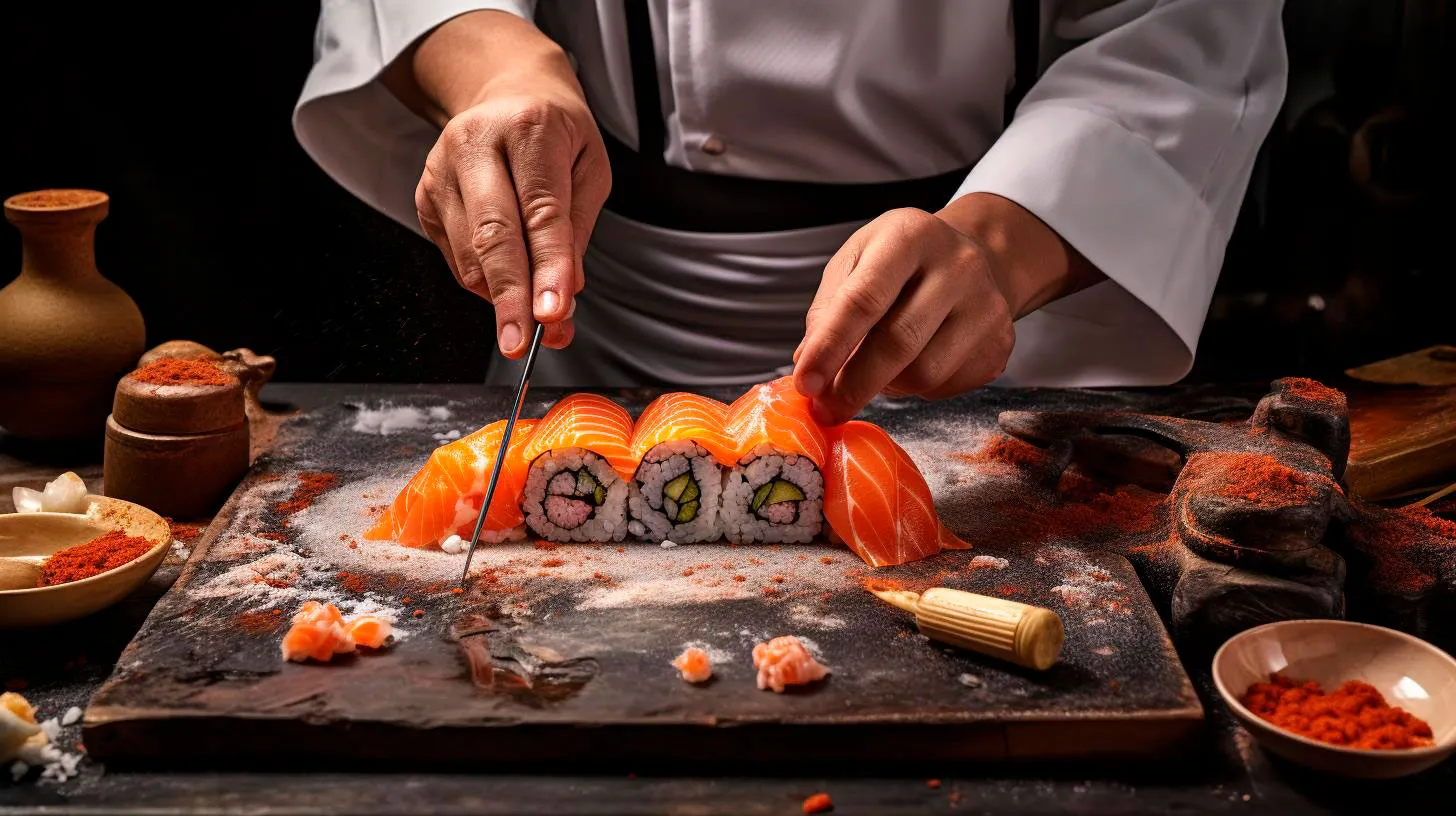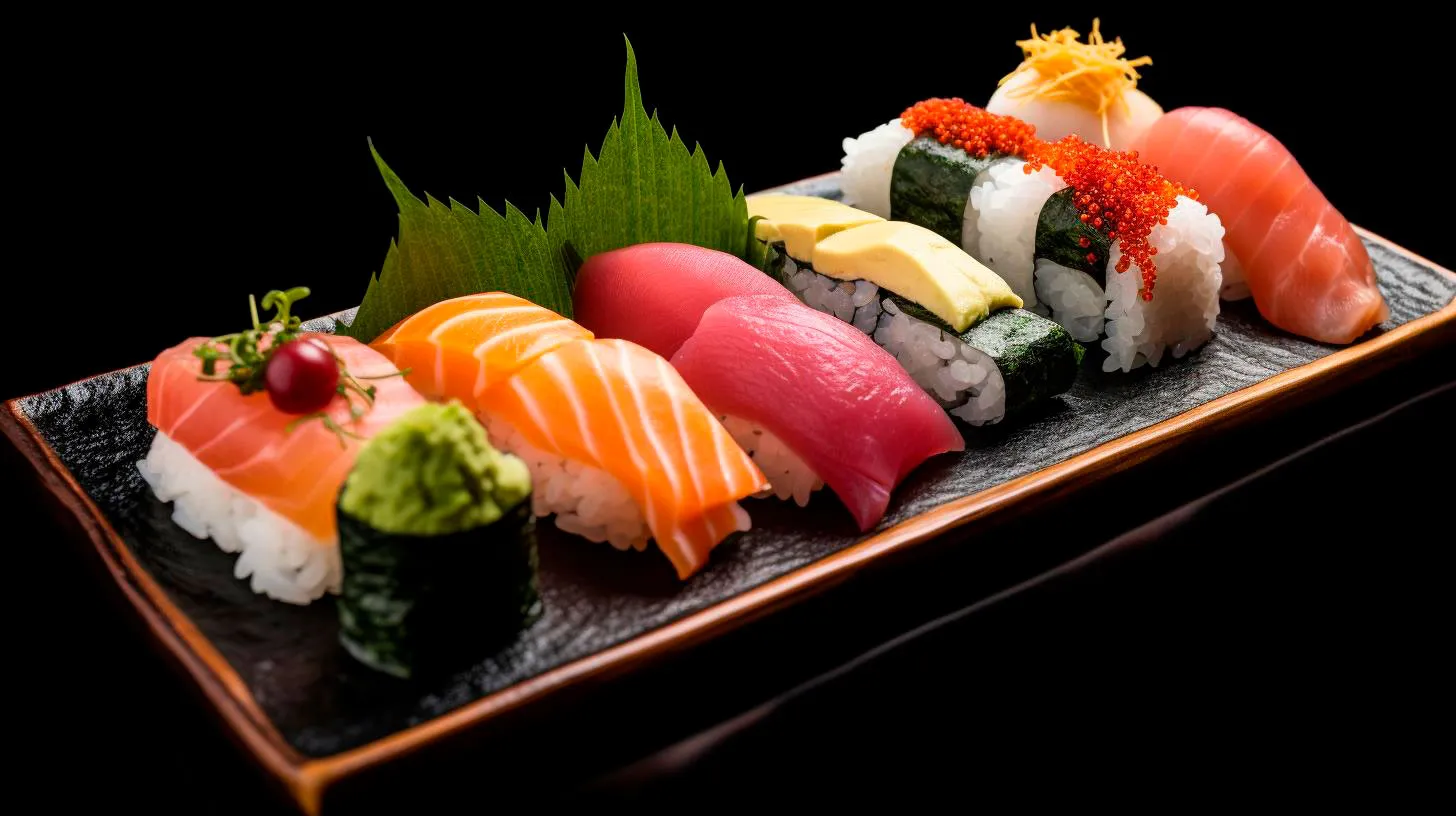The Art of Sushi Making: Exploring Japanese Culinary Traditions
But there’s more to sushi than meets the eye. In this article, we delve into the art of sushi making and explore the fascinating world of Japanese culinary traditions.
The Origins of Sushi
Sushi, as we know it today, traces its origins back to ancient Japan. Originally, sushi was a method of preserving fish by fermenting it with rice. This fermentation process allowed the fish to be stored for months, providing a valuable source of protein during long winters. Over time, sushi evolved into an art form, with chefs meticulously crafting delicate rolls and nigiri.
Key takeaways:
- Sushi originated in Japan as a method of preserving fish.
- Chefs transformed sushi into an art form over time.
The Types of Sushi
When it comes to sushi, there are various types to savor. Let’s take a closer look at some of the most popular ones:
1. Nigiri Sushi
Nigiri sushi is perhaps the most recognizable form of sushi. It consists of a small mound of vinegared rice topped with fresh seafood, such as tuna or salmon. The delicate balance of flavors and textures makes nigiri sushi a true delight.
2. Maki Sushi
Maki sushi, also known as sushi rolls, are made by wrapping a sheet of seaweed, called nori, around vinegared rice and various fillings. Popular fillings include cucumber, avocado, and crab. Maki sushi offers a burst of flavors with each bite.
3. Temaki Sushi
Temaki sushi, or hand rolls, are cone-shaped sushi rolls that you can easily hold in your hand. These rolls are typically filled with a combination of rice, fish, vegetables, and sauces. Temaki sushi is a great option for those who prefer to be more interactive with their food.
Key takeaways:
- Nigiri, maki, and temaki sushi are among the most popular types.
- Each type offers a unique experience and flavor profile.
The Secrets of Sushi Making
The art of sushi making requires precision, skill, and years of practice. Here are some key secrets that sushi chefs follow to create those mouthwatering masterpieces:
1. Quality Ingredients
The cornerstone of sushi is fresh, high-quality ingredients. From the fish and rice to the nori and vegetables, every component must be of the highest standard to create a memorable sushi experience.
2. Knife Skills
Sushi chefs undergo rigorous training to master the art of knife skills. The precision and finesse with which they slice and shape the fish and other ingredients are crucial to achieving the perfect balance of flavors and textures.
3. Rice Preparation
The rice used in sushi is not your ordinary rice. It’s a special short-grain variety that is cooked with precision. The vinegar seasoning, added after cooking, gives the rice its distinct flavor and texture.
4. Presentation
The presentation of sushi is as important as its taste. Chefs pay meticulous attention to detail, arranging the sushi in an aesthetically pleasing manner. The vibrant colors, garnishes, and artistic plating truly elevate the dining experience.
Key takeaways:
- Fresh, high-quality ingredients are essential for delicious sushi.
- Knife skills, rice preparation, and presentation are key elements in sushi making.
The Health Benefits of Sushi
Aside from its delectable taste, sushi offers numerous health benefits. Some of the key advantages of including sushi in your diet are:
1. Omega-3 Fatty Acids
Fish, a primary ingredient in sushi, is an excellent source of omega-3 fatty acids. These essential fats help promote heart health, reduce inflammation, and support brain function.
2. Low-Calorie Option
For those watching their calorie intake, sushi is a great choice. With its focus on fresh fish and vegetables, sushi can be a low-calorie and nutritious meal option.
3. Antioxidants from Nori
The nori used in sushi rolls is a type of seaweed that is rich in antioxidants. These powerful compounds help fight against free radicals in the body, providing potential anti-aging and anti-inflammatory benefits.
Key takeaways:
- Sushi offers omega-3 fatty acids, low calories, and antioxidants.
- Incorporating sushi into your diet can have various health benefits.
Conclusion
Sushi making is an art form that combines culinary expertise, precision, and an appreciation for quality ingredients. From its humble origins as a preservation method to its current status as a global gastronomic phenomenon, sushi truly reflects the essence of Japanese culinary traditions. Whether you’re a sushi lover or a novice, exploring the intricacies of sushi making is a journey worth taking. So, the next time you indulge in this delightful Japanese delicacy, savor each bite and marvel at the skill and tradition behind it.
Culinary Schools Bridging Technique and Creativity in the Kitchen
The Importance of Culinary Schools
Culinary schools serve as a breeding ground for talented chefs, preparing them to thrive in a highly competitive industry. Here’s why these institutions are so vital:
- Technical Knowledge: Culinary schools instill a strong foundation in cooking techniques, ranging from knife skills to mastering various cooking methods. This knowledge is essential for aspiring chefs as it forms the backbone of their culinary repertoire.
- Exposure to Diverse Cuisines: These schools expose students to a wide array of cuisines from around the world. By learning different flavor profiles and techniques, chefs can expand their culinary horizons and diversify their menus.
- Hands-on Experience: Culinary schools provide students with ample opportunities to gain hands-on experience in professional kitchens. This practical training ensures that chefs are well-prepared for the fast-paced and demanding nature of the culinary industry.
- Career Development: These institutions often have strong industry connections and partnerships, enabling students to access internships, mentorship programs, and job placements. This support greatly enhances students’ career prospects in the culinary field.
Emphasizing Technique
Technique is the backbone of any successful dish. Culinary schools prioritize teaching students the essential skills required to execute recipes effectively and consistently. Here are a few key techniques that culinary students focus on:
Knife Skills
Knife skills are essential for any chef. Culinary schools emphasize proper knife handling techniques, teaching students how to dice, chop, and slice ingredients efficiently. Mastering knife skills not only enhances speed and efficiency in the kitchen but also improves the presentation of dishes.
Cooking Methods
From grilling to braising, culinary schools educate students on a wide range of cooking methods. Understanding how temperature, time, and seasoning affect the outcome of a dish allows chefs to create flavorsome and well-cooked meals consistently.
Plating and Presentation
The visual appeal of a dish is just as important as its taste. Culinary schools emphasize the art of plating and presentation, teaching students techniques to enhance the visual appeal of their creations. From garnishing to arranging elements on a plate, chefs learn to create stunning and visually pleasing dishes that captivate diners.
Unlocking Creativity in the Kitchen
While technique forms a strong foundation, creativity is what sets exceptional chefs apart. Culinary schools understand the significance of nurturing students’ creativity and provide them with the tools to unleash their imagination. Here’s how they encourage creativity:
Ingredient Exploration
Culinary schools expose students to a wide range of ingredients, encouraging experimentation and creativity within recipes. By exploring unique flavors, chefs can create innovative and memorable dishes that surprise and delight diners.
Menu Development
Creating a well-balanced and enticing menu requires both technical expertise and creative flair. Culinary schools guide students in developing menus that showcase their personal style while considering customer preferences and industry trends. This skill allows chefs to create unique dining experiences that leave a lasting impression on their guests.
Collaborative Environment
Culinary schools provide a platform for collaboration and idea sharing among aspiring chefs. Students have the opportunity to work together on projects, sparking creativity through discussions and the fusion of different culinary backgrounds. This collaborative environment fosters innovation and pushes the boundaries of traditional cooking.
The Key Takeaways
Culinary schools are the perfect blend of technique and creativity, enabling aspiring chefs to take their culinary prowess to new heights. Here are the key takeaways from this blog post:
- Culinary schools provide aspiring chefs with essential technical knowledge and exposure to diverse cuisines.
- Emphasizing technique, culinary schools focus on knife skills, cooking methods, and plating.
- Unlocking creativity, these schools encourage ingredient exploration, menu development, and collaboration.
By enrolling in a reputable culinary school, aspiring chefs can harness their passion, refine their skills, and embark on a rewarding journey in the world of gastronomy.
Mastering the Craft: Unveiling the Secrets of Sushi Making
However, sushi making is an art that requires precision, skill, and attention to detail. In this article, we will delve into the secrets of sushi making, providing you with a comprehensive guide to mastering this culinary craft.
The Essential Ingredients
The foundation of sushi making lies in its ingredients. To create authentic and delicious sushi, you need the following essentials:
- Rice: Sushi rice plays a crucial role in the overall taste and texture of the dish. Short-grain Japanese rice is the preferred choice as it has the right balance of stickiness and firmness.
- Seafood: The freshest seafood is key to creating exceptional sushi. From salmon and tuna to shrimp and eel, the selection of fish is vast and diverse.
- Vegetables: Sushi is not limited to seafood; it also offers a plethora of vegetarian options. Cucumber, avocado, and pickled vegetables are popular choices to add a refreshing crunch.
- Seaweed: Nori, a type of seaweed, is used to wrap sushi rolls. It adds a unique umami flavor and provides texture to the dish.
- Sauces and condiments: Soy sauce, wasabi, and pickled ginger are commonly served alongside sushi to enhance its flavors.
By carefully selecting high-quality ingredients, you can elevate the taste and authenticity of your sushi creations.
The Techniques in Sushi Making
Sushi making is an intricate process that involves various techniques. Here are a few fundamental techniques that every sushi enthusiast should master:
1. Rice Preparation:
The technique of preparing sushi rice is essential. To achieve the perfect texture, the rice must be washed to remove excess starch and then cooked with the right amount of water. Once cooked, it is seasoned with a mixture of rice vinegar, sugar, and salt.
2. Nigiri:
Nigiri is a type of sushi where a small mound of rice is shaped by hand and topped with a slice of fresh fish. The skill lies in creating perfectly sized and balanced nigiri pieces that showcase the flavors of both the rice and the fish.
3. Maki Rolls:
Maki rolls are made by tightly rolling sushi rice, fish, and vegetables in a sheet of nori. The key is to evenly spread the rice and ingredients, and then roll it tightly to create a well-formed cylindrical shape. Once rolled, it is cut into bite-sized pieces.
4. Sashimi:
Sashimi refers to thin slices of raw fish or seafood served without rice. The art here lies in selecting and slicing the fish with precision to achieve a delicate flavor and texture.
The Advantages of Making Sushi at Home
Making sushi at home can be a rewarding experience. Here are a few advantages to consider:
- Cost-effective: Dining at sushi restaurants can be expensive. Making sushi at home allows you to enjoy this delicacy without breaking the bank.
- Creative freedom: When making sushi at home, you have the freedom to experiment with different ingredients and create unique combinations to suit your taste.
- Healthier options: By controlling the ingredients and portion sizes, you can make healthier choices while still savoring the flavors of sushi.
- Social experience: Making sushi at home can be a fun activity to share with family and friends, offering an interactive and enjoyable culinary experience.
Key Takeaways
Making sushi is an art that requires practice, patience, and attention to detail. By mastering the essential techniques and using high-quality ingredients, you can create sushi that rivals that of top sushi chefs. Remember these key takeaways:
- Choose the freshest ingredients to enhance the flavor and authenticity of your sushi.
- Master the techniques of rice preparation, nigiri, maki rolls, and sashimi to create visually appealing and delicious sushi.
- Enjoy the advantages of making sushi at home, such as cost-effectiveness, creative freedom, and healthier options.
So, unleash your inner chef, gather the necessary ingredients, and embark on a journey to master the art of sushi making. With practice and dedication, you’ll be delighting your taste buds and impressing others with your homemade sushi creations!
Blending Tradition and Innovation: Culinary Schools’ Approach to Sushi Techniques
The Art of Sushi: A Brief Overview
Sushi is much more than just raw fish. It is an art form that dates back centuries, with origins in ancient Japan. Traditionally, sushi was made by highly skilled itamae (sushi chefs) who meticulously prepared the ingredients and crafted each piece with precision.
However, with the rising popularity of sushi, culinary schools have recognized the need to adapt their teaching methods to meet the demands of aspiring sushi chefs. These schools strive to maintain the essence of traditional sushi while introducing contemporary techniques and innovations.
The Role of Culinary Schools
Culinary schools play a pivotal role in shaping the future of sushi. They provide aspiring chefs with the necessary knowledge and skills to excel in this challenging culinary art. Let’s explore some key aspects of how culinary schools are approaching sushi techniques:
1. Emphasis on Traditional Foundation:
Despite incorporating modern techniques, culinary schools recognize the importance of mastering the traditional foundation of sushi-making. Students learn the significance of sourcing the freshest ingredients, including seasonal fish and vegetables, and understanding the art of rice preparation. The foundations of sushi-making are rooted in tradition, ensuring authenticity and respect for the craft.
2. Introduction to New Ingredients:
Innovation in sushi techniques also involves introducing students to a wider range of ingredients. While maintaining respect for traditional elements, culinary schools encourage experimentation with new flavors and ingredients. This allows aspiring sushi chefs to create unique and exciting culinary experiences for their customers.
3. Integration of Technology:
In an increasingly digital world, culinary schools are embracing technology to enhance the learning experience. Immersive virtual reality (VR) programs allow students to virtually step into a sushi restaurant and practice their skills in a simulated environment. This integration of technology not only makes learning more engaging but also prepares future sushi chefs for the evolving industry trends.
Benefits of the Blended Approach
The blending of tradition and innovation in sushi techniques brings numerous advantages, both for aspiring chefs and diners craving unique culinary experiences. Here are some key takeaways:
- Preservation of Authenticity: By mastering traditional sushi techniques, chefs ensure the preservation of Japan’s culinary heritage.
- Creative Flair: Introduction of new ingredients and techniques allows chefs to showcase their creativity, resulting in exciting and innovative sushi combinations.
- Customer Satisfaction: Blending tradition and innovation ensures that diners experience the best of both worlds – the classic flavors they love, along with innovative twists to keep their palate intrigued.
- Evolving Industry: Culinary schools’ approach reflects the ever-changing culinary landscape, equipping chefs with the skills to adapt to new trends in the sushi industry.
Final Thoughts
Sushi, with its rich history and delightful flavors, continues to captivate food enthusiasts worldwide. Culinary schools have recognized the immense potential of sushi and have adapted their teaching methods accordingly. By blending tradition and innovation, these schools equip aspiring chefs with the skills and knowledge to maintain the authenticity of sushi while pushing boundaries to create exciting new culinary experiences.
As sushi’s popularity continues to soar, the fusion of tradition and innovation in culinary schools ensures that sushi techniques evolve with the times, catering to the demands of a dynamic and diverse culinary landscape.



